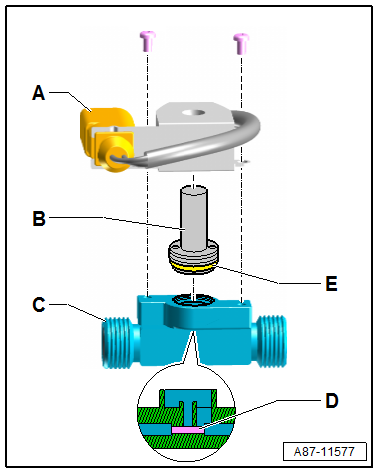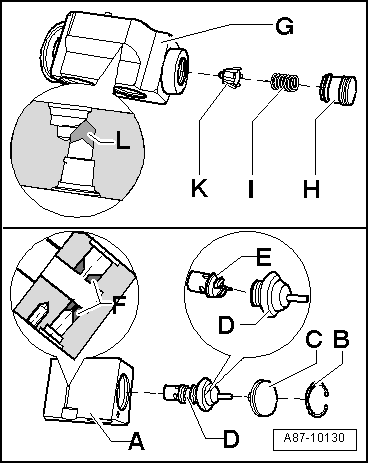| Remove the solenoid coil -A-
and the solenoid valve -B- before
drilling open. |
| Drill open the shut-off valve -C-
using a suitable drill (diameter of the drill for example 5.0
mm). |
| Clean the shut-off valve -C-
from shavings produced by drilling -D-. |
| Install the solenoid valve -B-
with the seals belonging to it -E-
on the drilled open shut-off valve -C-. |
| – |
Check refrigerant quantity in the refrigerant cylinder,
there must be at least 7 kg of refrigerant R134a. |
 Note Note
| If necessary, switch on the heater installed on the
refrigerant cylinder for 30 minutes before the first flushing
procedure. This increases pressure in the refrigerant cylinder
and accelerates charging of the flushing circuit. |
| – |
Evacuate the A/C service station old oil container. |
| – |
Connect the supply hose (high pressure side) of A/C service
station to the low pressure line leading to the A/C compressor
(line with larger diameter) using an adapter. Refer to
→ Chapter „Adapter for Assembling Flushing Circuit“. |
| – |
Connect return hose (low pressure- or intake side) of A/C
service station to output of refrigerant circuit flushing
device. |
| – |
Connect the input on the refrigerant circuit flushing device
to the high pressure line leading to the A/C compressor (line
with smaller diameter) using an adapter. Refer to
→ Chapter „Adapter for Assembling Flushing Circuit“. |
 Note Note
| Components are always (with the exception of the
electrically-driven A/C compressor) flushed in the opposite
direction of refrigerant flow when the A/C system is operating.
Refer to
→ Chapter „Flushing Circuit Block Diagrams“.
|
| While flushing, contaminants from the refrigerant circuit
enter the refrigerant circuit flushing device and the A/C
service station and are absorbed by the filters and dryers
installed there. Depending on the contaminant, these components
are to be replaced in shorter intervals in line with operating
instructions for A/C service station or refrigerant circuit
flushing device.
|
| The filter in the refrigerant circuit flushing device
depends on the type and degree of contamination in the flushed
refrigerant circuit. It should be replaced after 2 flushing
cycles, at the most. If a heavily contaminated refrigerant
circuit is flushed (the refrigerant oil from the circuit is
black and viscous or there are many shavings in the refrigerant
circuit), the filter should be replaced after flushing. With a
refrigerant circuit heavily contaminated in this way, it is wise
to flush the circuit again after changing the filter. |
| Depending on the type of contamination, dirt (old
refrigerant oil and abraded material from A/C compressor) is
deposited on the viewing glass(es). Clean viewing glass(es)
after flushing and flush the refrigerant circuit once more with
one flushing procedure as a check. |
| Fluid refrigerant cannot be conducted with the necessary
speed through the expansion valve, restrictor and desiccant bag
of certain receiver/dryers, therefore these components must be
removed and replaced by an adapter. Refer to Heating,
Ventilation & Air Conditioning. |
| Adapters for connecting A/C service station and for bridging
certain components of refrigerant circuit. Refer to
→ Chapter „Adapter for Assembling Flushing Circuit“. |
| – |
Switch on the service station and flush the refrigerant
circuit (duration for one flushing cycle with three flushing
procedures is approximately 1 to 1.5 hours for about 4Kg of
coolant R134a). |
 Note Note
| Perform flushing of refrigerant circuit according to
operating instructions of the A/C service station. |
| Depending on A/C service station version, the old oil
container holds only approximately 125 cm
3 of refrigerant oil. In the event a system with a larger
volume of refrigerant oil must be flushed, it may be necessary
to empty the old oil container after the first flushing
procedure of a flushing cycle. |
| Observe the refrigerant which flows back from the
refrigerant circuit. The refrigerant circuit is only clean when
the refrigerant flows clear and completely colorless through the
viewing glass(es) on the flushing device in the A/C service
station. |
| When flushing, the complete amount of refrigerant oil is
washed out of the refrigerant circuit (except for minor remains
which can be disregarded). |
| If contamination is especially severe, it may be necessary
to perform the flushing cycle twice (two flushing cycles with
three flushing operations each). Before the second flushing
cycle, the filter on the flushing device must be replaced. |
| Sequence of flushing procedure (sequence occurs
automatically according to the A/C service station program) |
| After switching on, the flushing circuit (refrigerant
circuit with connecting hoses and refrigerant circuit flushing
device) is first evacuated and the refrigerant circuit is
simultaneously checked for leaks. Depending on A/C service
station version, it is possible that manually switching to
advance the program is required. |
| A prescribed amount of refrigerant (e.g. 4 kg) is filled
into the evacuated flushing circuit via the high pressure side
of the A/C service station (opposite the normal direction of
flow during normal A/C system operation and thus on the low
pressure side of vehicle refrigerant circuit). Depending on the
version of the A/C service station, refrigerant is added until
the flushing circuit is completely full. This can be detected by
e.g. refrigerant no longer flowing in after a certain period of
time. |
| After the prescribed quantity of refrigerant has been
filled, for example. the heater for the refrigerant circuit
flushing device is switched on (only in the event the
refrigerant is extracted in gaseous form from the refrigerant
circuit flushing device), depending on version of A/C service
station and refrigerant circuit flushing device. |
| After the refrigerant has been extracted, the heater on the
refrigerant circuit flushing device (if applicable) switches
off, the refrigerant circuit may be evacuated again (depending
on the version), and the refrigerant oil extracted from the
refrigerant circuit is separated by the A/C service station
after evacuating. |
| The sequence of filling refrigerant, extracting (and
evacuating) is repeated twice (performed a total of three
times). |
| After the third extraction, the flushing circuit is
evacuated depending on the version of the A/C service station. |
| – |
After the flushing cycle has ended, check the viewing
glass(es) on the flushing device. If they are dirty, clean them
according to the instructions for the flushing device or A/C
service station. Perform one addition flushing cycle as a check.
One flushing procedure is sufficient (approximately 30 min.) |
| – |
Check pressure in refrigerant circuit, there must be no
positive pressure in the refrigerant circuit (evacuate
refrigerant circuit briefly once more if necessary). |
| – |
Disconnect A/C service station connections from vehicle
refrigerant circuit. There must be no positive pressure in the
refrigerant circuit. |
| – |
Replace these vehicle-specific components. |
| Expansion valve and receiver/dryer or dryer cartridge in
receiver/dryer |
| – |
Refer to Heating, Ventilation & Air Conditioning and the
Parts Catalog. |
| – |
Depending on the complaint, replace A/C compressor. Refer to
Heating, Ventilation & Air Conditioning and the Parts Catalog or
drain the remaining refrigerant oil from the removed A/C
compressor. Refer to
→ Chapter „Components, Replacing“ (replace
refrigerant circuit components) and refill the prescribed
quantity of fresh refrigerant oil. Refer to the vehicle-specific
repair manual. |
 Note Note
| A certain prescribed quantity of refrigerant oil is in the
A/C compressor original part. If the vehicle has two
evaporators, then the refrigerant circuit requires a specific
quantity of refrigerant oil. Refer to the vehicle-specific
repair manual. |
| If the A/C compressor is not be replaced, the quantity of
refrigerant oil in the A/C compressor must be topped off to the
prescribed capacity (tilt the refrigerant oil out and refill the
prescribed quantity into the A/C compressor or refrigerant
circuit). Refer to
→ Chapter „Components, Replacing“ (replacing
refrigerant circuit components) and vehicle-specific repair
manual. |
| – |
Completely reassemble the refrigerant circuit. Refer to
Heating, Ventilation & Air Conditioning. |
| – |
Evacuate and recharge refrigerant circuit according to
specification. Refer to
→ Chapter „Refrigerant Circuit with A/C Service Station,
Draining“ and
→ Chapter „Refrigerant Circuit with A/C Service Station,
Filling“. |
| – |
Start up A/C system according to specification. Refer to
Heating, Ventilation & Air Conditioning and
→ Chapter „A/C System, Operating after Charging“. |
|
|

|
 Note
Note Note
Note Note
Note Note
Note Note
Note Note
Note Note
Note Note
Note Note
Note Note
Note Note
Note Flushing Circuit Block Diagrams
Flushing Circuit Block Diagrams
 WARNING
WARNING Caution
Caution

